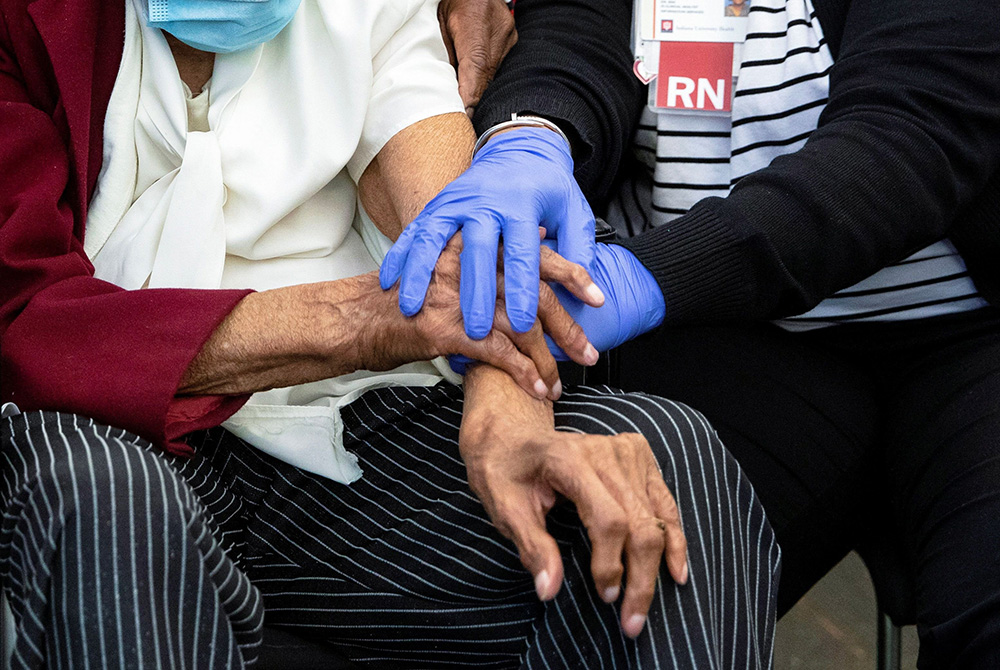
A 111-year-old woman is comforted by a nurse following her COVID-19 vaccination at IU Health Neuroscience Center March 16 in Indianapolis. (CNS/Chris Bergin, Reuters)
We often hear that Jesus, becoming human, identified with us. I wonder sometimes, though, how often we forget the flip side — we in return are meant to identify with God. I don't mean this in any grandiose or cultish way, lest you worry. No — Christ wanted us to see our divinity in the midst of our fragile, beautiful humanity.
I don't know about you, but I've put myself in the shoes of nearly everyone in the Resurrection stories. I've been Mary Magdalene at the tomb and in the garden. I've imagined myself on that road to Emmaus more times than I can count. More often than not, I've seen myself as Thomas, needing to see for myself that the good news is true. But never have I placed myself in the perspective of Jesus during the Easter story.
I always feel an urge to distance myself from the resurrection of Jesus. It's the least relatable moment in the Bible for me, in some ways, because it's the moment when Jesus transcends the limitations of being human. He conquers what is a constant for us, or what we think is — death. And this year, death has felt like a constant, more so than ever. I've felt very limited, very earthly and powerless.
That is, until I placed myself in the experience of Jesus. After all, he had just experienced his most human moment of all — the moment he cried out, "My God, why have you forsaken me?" He too felt powerless against forces of death and unjust authority. He too felt so earthly, so breakable. And he too died.
And then came the moment more confusing than all the others — he got up again. He rose from the tomb.
Christ wanted us to see our divinity in the midst of our fragile, beautiful humanity.
Christ's resurrection is more than a symbol of faith; it's a model of rebirth for all of us. It shows the resilience of God — and of God in humanity — during a time of violence and turmoil. The Jesus that the disciples meet in the Gospel of John is a wounded one, a man who carries his scars not to nurse them, but to live beyond them.
What does it mean then, to be deeply wounded and scorned, and then to die? And what does it mean to stand up in the face of death, to know death, and to walk away?
At the end of Lent and the beginning of this Easter season — and at the tail end of this pandemic and the beginning of the vaccination season — I wonder what it means to live beyond the scars.
We've seen and felt, as a society, so many wounds this past year. We've seen death and racial injustice, staggering inequality, high unemployment numbers, loneliness, depression and fatigue. News on the worsening state of the climate continues to grow, and civic discourse has turned vitriolic. In the midst of the chaos and tragedy, I've been like the disciples, fretting and pacing, visiting the tomb of grief under the cover of night, needing the reassurance of seeing Jesus again, struggling to comprehend that news might be good sometimes.
It's high time for a change in perspective — signs of new life, of resurrection, need not always be outward-facing. I always look for resurrection and hope in outer signs — in the headlines, or in spring flowers, or in kind words or touching moments. On quieter days, without all of the obvious signs, the faith falters.
So maybe it's time to look elsewhere for our hope. It's time to look inward. The shift makes the moment of resurrection radically different. It's not a moment of belief or creed so much as a moment of deep assurance, a moment of wholeness that looks out on the world's cruelty with a sense of radical peace and embodied justice living within the self. Resurrection need not be sought, need not be believed — it need only be lived and known.
Advertisement
More than anything, that moment of resurrection, imagined in the mind of Christ, is one of mercy. Living like Jesus on the first Easter day means showing mercy toward others on a level that the world is unfamiliar with. It means finding the strength of life in our hearts to get up in the midst of global tragedy, dust ourselves off and rebuild — feed, clothe, free, comfort one another in a way that leans on the strength of God, in a way that is deeply brave and defiant of death. That is the lesson of the empty tomb — nothing can stop the work of God.
Nothing can change the abiding feeling in our hearts of God's presence and vitality within us and around us. It's the feeling that compels acts of service and connection. It's the feeling that calls us to pick up the phone, to join the Zoom call, to walk, to donate, to pray, to teach. It's the feeling that asks us to hope and to do, even when death seems all-encompassing and our surroundings too dark.
To see the resurrection from Jesus' eyes is to give up the usual question of Christianity: Do you believe? Instead, seeing in this way calls us to live out the charge of Christ — to proclaim the triumph of justice, mercy and peace over the forces of death and division. It's not a sight of Jesus' hands as Thomas saw them so much as the knowledge that wounded hands can heal, and that what was dead in us can come back alive.
The long slumber of the tragedy of this past year is what also calls us now to awaken as agents of love and hope. In the assurance and mercy of God, I hope we can all, together, build a world from our wounded yet enlivened selves, charged with a call that surpasses death. It is time to show the world the life of God in ourselves, and to turn the mercy our faith calls us to show inwards toward our wounded hearts. We don't need always to look out for signs of resurrection — we don't even need to know what the Resurrection is, as long as we can embody new life, getting up and walking forward to do the work of God.







